Year 1 History: Ancient Times
It becomes really fascinating when you study world history chronologically and see how interconnected everything is, all the causes and effects.
We use Tapestry of Grace for book lists, but I also peruse Ambleside Online and other lists for a well-rounded history curriculum. I want all sides and perspectives.
We use this text as a guide, especially for younger kids: The Story of the World: Ancient Times: From the Earliest Nomads to the Last Roman Emperor
For older kids: The History of the Ancient World: From the Earliest Accounts to the Fall of Rome and The Penguin Historical Atlas of Ancient Civilizations and Warfare in the Classical World
I go to the library about every week and get what I can.
I shop thrift stores, yard sales, half-price and used bookstores to get books we love to read again and again.
Other books we use throughout our history studies – over several years:
- This Country of Ours by HE Marshall
- Our Island Story by HE Marshall
- The Struggle for Sea Power by MB Synge
- A Child’s History of the World by Hillyer
- Encyclopedia of the Ancient World
- The Story of Mankind by Hendrik Willem van Loon
- Magic Treehouse
- If You Grew Up…
- American Girl Collection and Real Stories From My Time
- The Royal Diaries
- Dear America

We love Netflix and Amazon Prime for streaming. We sometimes view YouTube.
We love making fun maps with salt dough (also here), cookies, or play dough.
The Holman Bible Atlas comes in handy throughout this school year.
See how we do history.

We actually begin this school year with our family history. We make a family timeline and learn our family tree.
Ancient history consists mainly of Celts, China, Maya, Egypt, Greece, and Rome.
We also chronologically study early cultures like Sumeria, Phoenicia, and Assyria along with China, India, and the Americas.
Ancient Times is probably our favorite historical year.

Unit 1: Earliest Times
- Earliest Peoples
- Ancient Babylon
- Ancient Egypt
- Ancient Israel
History
Literature
Bill and Pete go Down the Nile
Ali Baba and the Forty Thieves
Activities
Ancient Egyptians and Their Neighbors
Ancient Israelites and Their Neighbors
Learn about Pyramids
Make cuneiform writing.
Make apple, chicken, or doll mummies.
Celebrate the Jewish feasts – Dance, Sing, Remember, Jewish Holidays all the Year Round, Walk with Y’shua through the Jewish Year
We celebrate Passover, Purim, Sukkot, Rosh Hashanah, and Hanukkah every year now.
Visit a museum or exhibit on Egypt or archaeology
We visited an Egyptian exhibit in Houston our first year homeschooling. We’ve been to the Egyptian exhibits at the Vatican and Louvre, also Chicago and Cincinnati. We love natural history museums!
Church History
Books of Moses (Torah)
Mythology
Creation stories and myths: In the Beginning
Movies

Unit 2: Early Civilizations
- Ancient India
- Ancient China
- Phoenicians
- Ancient Americas
- Early Greece
History
Ancient Americas to see for Yourself
Literature
Keepers of the Earth We really like the books by Joseph Bruchac.
See my Native American book list
Activities
See my China Unit Study
Make or go out for Greek, Indian, Chinese food
Practice calligraphy
Learn about henna
Make a mosaic tile
Play Parcheesi
Play with tangrams
Make a sand painting
Make a beaded headband
Visit a museum or exhibit on ancient China, India, Americas
We saw the Terracotta Army in Cincinnati.
We visit Native American sites when we can.
Church History
Mythology
Philosophy
1 and 2 Samuel
Movies
Crouching Tiger, Hidden Dragon
Unit 3: The Greek Empire
- Divided Kingdoms of Israel
- Assyrians
- Babylonians
- Persians
- Persian Wars with Greece
- Classical Greece: Athens & Sparta
History
The Librarian Who Measured the Earth
Literature
D’Aulaires Book of Greek Myths
Black Ships Before Troy and EVERYTHING Rosemary Sutcliff wrote
EVERYTHING written by Padraic Colum
Activities
Visit a museum or exhibit on Greece
We visited several places in Greece
Church History
Mythology
Philosophy
Old Testament Prophets
Movies
Unit 4: The Roman Empire
- Etruscans found Rome
- The Roman Republic
- The Roman Empire
- Ancient Celts
- Life of Christ
- Early church history in the context of the Roman Empire
- Roman Empire is split
- Fall of Western Roman Empire
History
City: A Story of Roman Planning
Literature
The Ides of April and Beyond the Desert Gate
One Hundred and One Celtic Myths
Fairy Folk of the Irish Peasantry
Roman Britain Trilogy: Eagle of the Ninth, The Silver Branch, The Lantern Bearers
Activities
Learn how to make olive oil and try different kinds
Make pasta
Have a Roman feast
Visit a museum or exhibit on Rome
We visited Rome over Christmas one year
We visited Ireland and saw Tara and Newgrange.
Church History
Mythology
Philosophy
The Gospels
Paul
Early Christians
Movies
I’m still adding to and updating my list. I love researching and learning with my kids.
See my Pinterest board for Year 1 History:









































